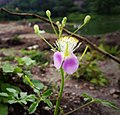| Cleome | |
|---|---|
 | |
| Cleome houtteana | |
| Scientific classification | |
| Kingdom: | Plantae |
| Clade: | Tracheophytes |
| Clade: | Angiosperms |
| Clade: | Eudicots |
| Clade: | Rosids |
| Order: | Brassicales |
| Family: | Cleomaceae |
| Genus: | Cleome L. |
| Synonyms [1] | |
List
| |
Cleome is a genus of flowering plants in the family Cleomaceae, commonly known as spider flowers, spider plants, spider weeds, or bee plants. [2] [3] Previously, it had been placed in the family Capparaceae, until DNA studies found the Cleomaceae genera to be more closely related to the Brassicaceae than the Capparaceae. Cleome and clammyweed ( Polanisia dodecandra ) can sometimes be confused.
Contents
The genus sensu stricto includes about 170 species of herbaceous annual or perennial plants and shrubs. [4] The genus has a subcosmopolitan distribution throughout the tropical and warm temperate regions of the world. [4] However, a recent DNA study failed to separate Cleome, Podandrogyne , and Polanisia from each other, so some taxonomists have abandoned the last two of these genera, treating them as part of Cleome sensu lato ; in this case, Cleome contains about 275 species, the vast majority of the Cleomaceae.
The genus contains species which show an evolutionary progression from C3 to C4 photosynthesis. This, combined with it being very close to the Brassicaceae with the model plant species Arabidopsis thaliana , makes it an ideal genus in which to study the evolution of C4 photosynthesis. Morphological differences that demonstrate the transition from C3 to C4 include C3 species having leaves with more veins and larger bundle sheath cells. Also, species such as Cleome gynandra produce proteins needed for C4 photosynthesis. [5] Three species independently acquired the C4 pathway, while others are C3–C4 intermediate or C4-like. [6]











